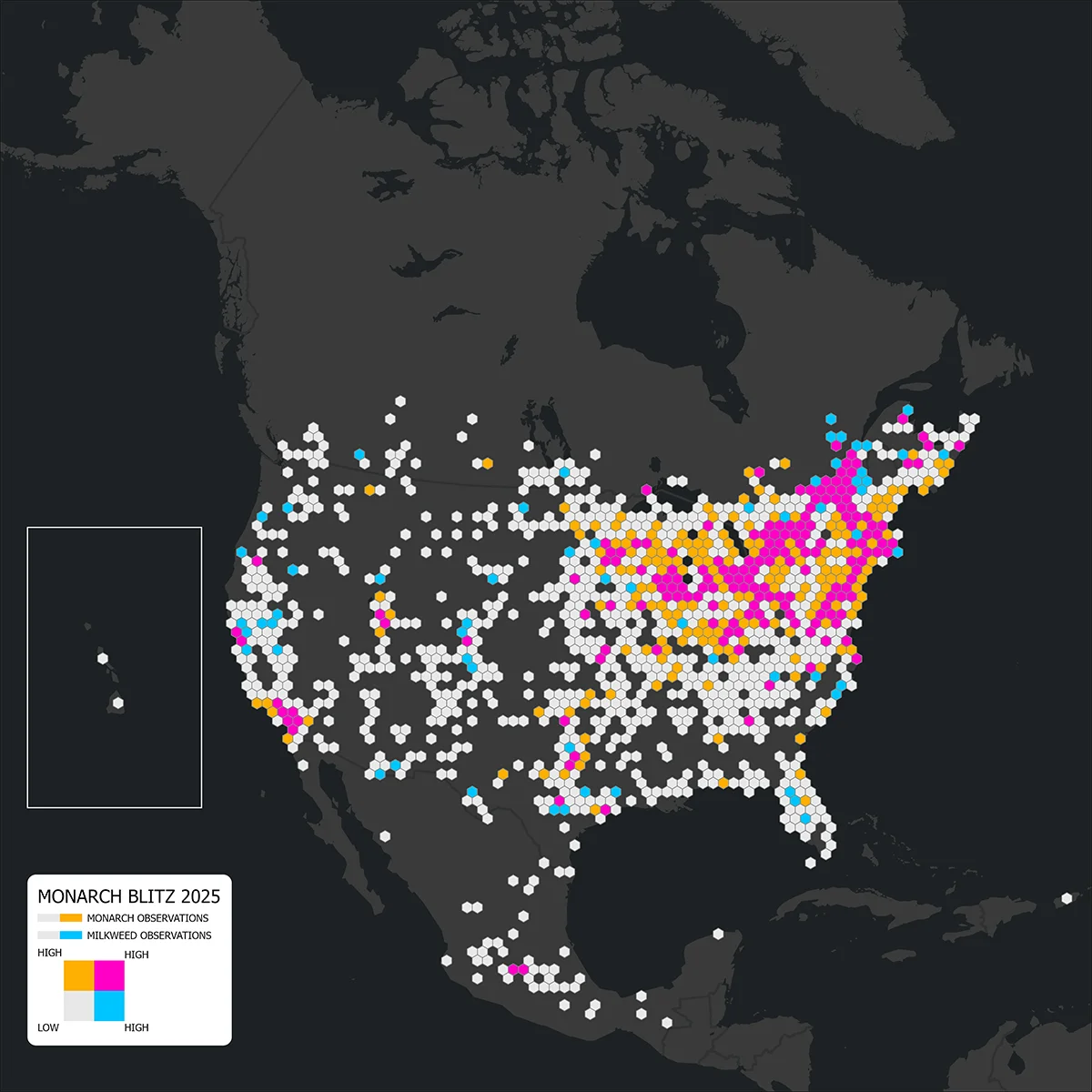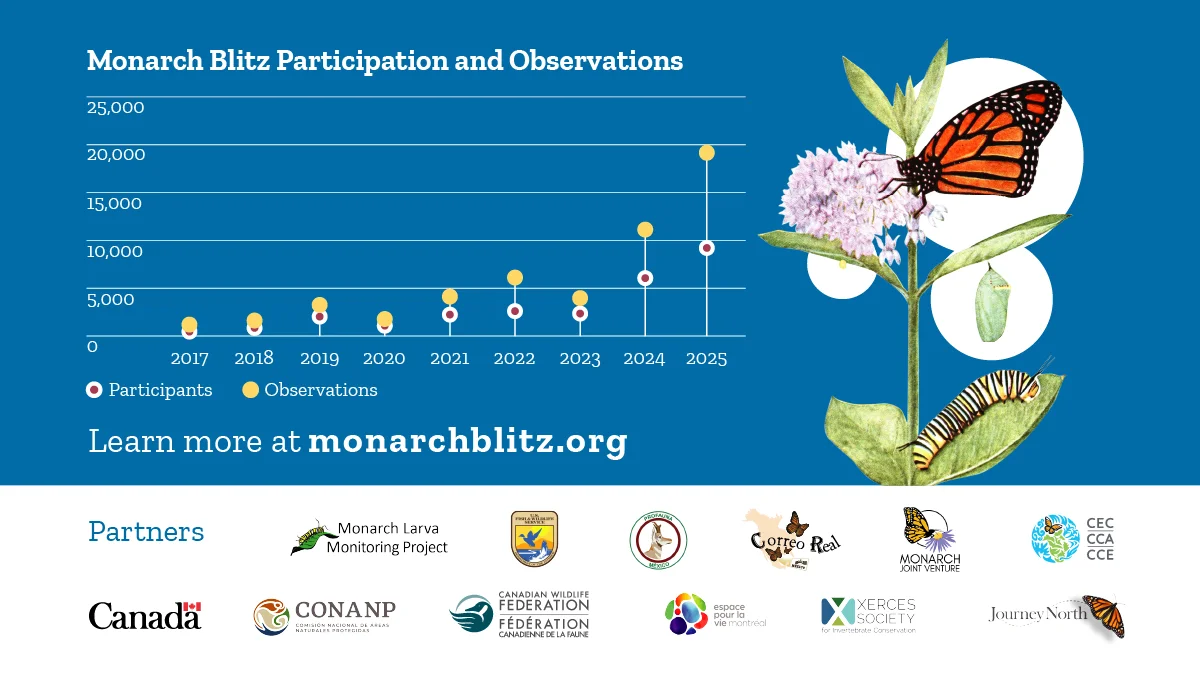Volunteers Breaking Observation Records to Support Monarch Butterfly Conservation Across North America
Tiohtià:ke (Montreal), 23 September 2025 — Over the past 15 years, monarch butterfly populations have faced serious challenges, but conservation efforts continue to grow. Canada, Mexico and the United States share a long history of working together to protect monarchs across their migratory range, including through Commission for Environmental Cooperation (CEC) initiatives like the International Monarch Monitoring Blitz.
From 25 July to 3 August 2025, the 9th edition of the Monarch Blitz invited individuals, organizations and community scientists from across North America to collect data on monarch butterflies and the milkweed plants essential for their survival. This snapshot of monarch populations and their breeding habitats supports conservation efforts by informing scientific research, helping guide local actions—in rural and urban areas—and promoting the engagement of municipalities to contribute meaningfully to conservation efforts.
This year’s Monarch Blitz saw over 9,000 volunteers participate—a remarkable increase from last year's 5,798—all working together across Canada, Mexico and the United States. These dedicated volunteers reported more than 33,000 monarch sightings, nearly twice as many as last year’s 16,161. They also tracked over 71,000 milkweed plants, surpassing the 68,460 plants recorded in 2024.

“Community science efforts like the International Monarch Monitoring Blitz are great opportunities to spark interest in conservation and the natural world, so it's very encouraging to see participation jump this year, both in the number of reports submitted and the number of people participating. I'm excited to see that momentum continue through this year's fall migration and beyond,” said Jacob Swanson of Journey North.
Data collected during the Blitz are compiled in the Trinational Monarch Knowledge Network, a public, open-access repository of information. This source is available to consult and download for educators, researchers, policymakers, NGOs, city planners, parks departments, museums, community organizations and anyone working to protect monarchs and biodiversity across North America.
“The information collected by people is extremely valuable, helping us plan where we need to restore or create monarch habitat, and here in Canada it’s looking like we need to go further north than we previously might have thought. Of the nearly 8,000 monarch observations recorded by iNaturalist during the Blitz, some showed monarchs ranging much farther north than had been previously expected—up to 100 km farther in some cases—and that was from just one of the six platforms people were using to record their observations,” said James Page of the Canadian Wildlife Federation.
We extend our heartfelt thanks to every individual and organization that ventured into nature to help monitor the monarch butterflies and the milkweed plants they depend on. The conservation of the monarch butterfly is a shared responsibility—one that thrives on international collaboration and the dedication of volunteers. This year’s Blitz once again demonstrated the power of community science and the impact of every single observation.
"The Monarch Blitz in Mexico is highly relevant because it serves to heighten public interest in the monarch butterfly during the summer. As proof of this, this year the community participating in Correo Real held events along the migratory route to encourage people to go out and look for milkweed plants and monarchs. At Profauna, A.C., we believe that international and domestic collaboration are key to ensuring a prosperous migration for the monarch butterfly. For communities interested in conservation of this species, the Monarch Blitz initiative represents a successful example of this," said Jerónimo Chávez of Correo Real, a program of the organization Profauna, A.C.
By conserving monarch habitats—particularly milkweeds and nectar-rich areas—we are simultaneously protecting the broader environment that sustains many other species as well. Monarch conservation efforts, therefore, play a vital role in safeguarding biodiversity across North America, offering a powerful opportunity to support entire ecosystems through the protection of a single, iconic, North American species.
As we look ahead to 2026, we’re excited to celebrate the 10th anniversary of the International Monarch Monitoring Blitz—a milestone that will honor a decade of collective action, scientific discovery and a growing momentum in protecting monarchs and the ecosystems on which they depend. Let’s make next year our most impactful yet!
The Blitz is facilitated by the Commission for Environmental Cooperation and supported by collaborating organizations, including Environment and Climate Change Canada, the Insectarium de Montréal | Espace pour la vie and the Canadian Wildlife Federation in Canada, the National Commission of Protected Natural Areas (Conanp) and Profauna, A.C. in Mexico and the U.S. Fish and Wildlife Service, the Xerces Society for Invertebrate Conservation, Journey North and Monarch Joint Venture in the United States.
For more information on this year’s results, visit monarchblitz.org or follow #MonarchBlitz on social media. You can learn more about the participating community science programs below:
If you would like to know more about CEC initiatives, opportunities and efforts, you can sign up for our newsletter and follow us on social media.

